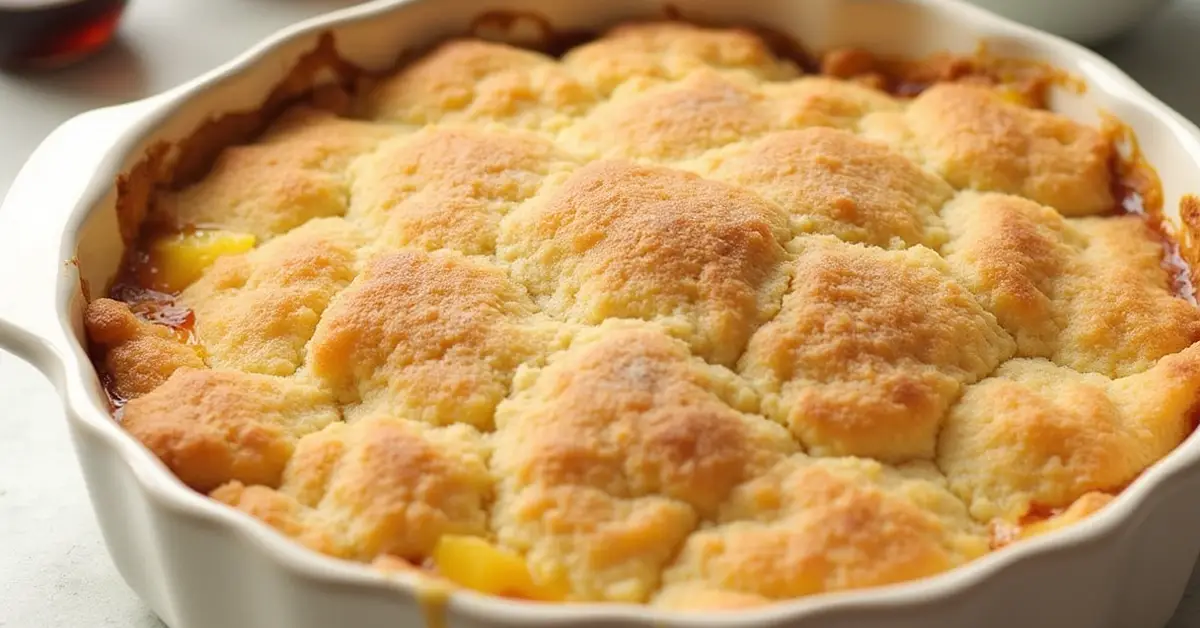There’s nothing quite as comforting as a warm, fruity dessert fresh out of the oven, and gluten-free peach cobbler is a perfect example of that. This delightful dessert combines the sweetness of ripe peaches with a crispy, golden topping, making it the ideal treat for any occasion. Whether you’re gluten-sensitive, looking to make healthier choices, or simply want a fresh twist on a classic dessert, this gluten-free peach cobbler is sure to satisfy your cravings.
Made with easy-to-find ingredients like gluten-free flour and juicy peaches, this dessert doesn’t sacrifice flavor for dietary needs. In fact, it’s so delicious that even non-gluten-free eaters will be asking for seconds! In this blog post, we’ll show you how to make a perfectly fluffy and flavorful peach cobbler that’s both gluten-free and completely irresistible.
Why Choose Gluten-Free Peach Cobbler?
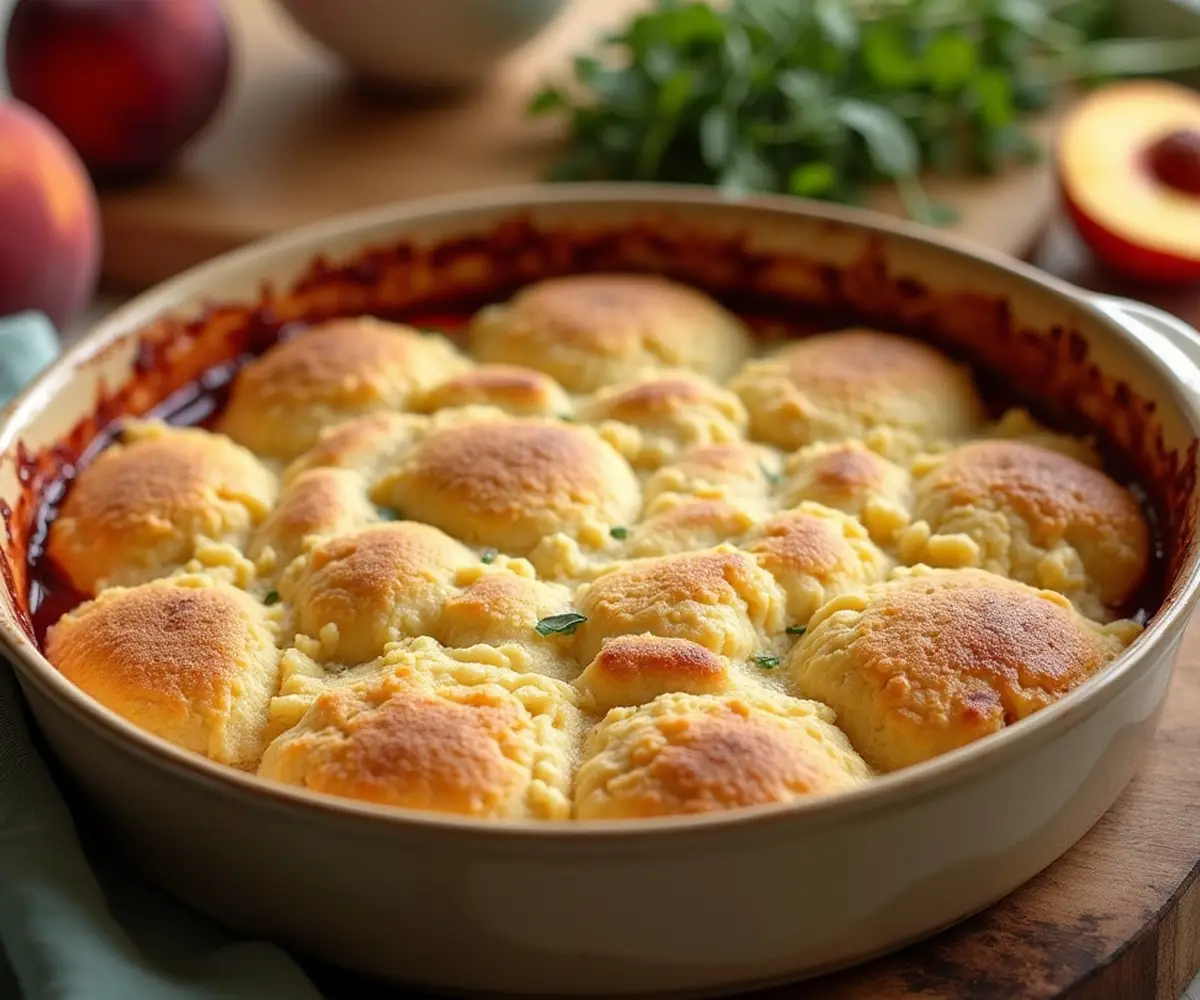
When it comes to classic desserts, few are as beloved as peach cobbler. The combination of sweet, juicy peaches and a buttery, biscuit-like topping is undeniably comforting. However, for those who follow a gluten-free lifestyle, traditional peach cobbler can often be off-limits due to its reliance on wheat flour. Fortunately, a gluten-free peach cobbler offers all the indulgent flavors of the original while being accessible to those with dietary restrictions. But why exactly should you opt for a gluten-free version of this dessert? Let’s dive into the benefits and reasons why gluten-free peach cobbler is a fantastic choice.
The Benefits of Going Gluten-Free
For individuals with gluten sensitivity or conditions like celiac disease, consuming gluten-containing foods can lead to uncomfortable symptoms and long-term health issues. Choosing gluten-free alternatives, like in this peach cobbler recipe, ensures a safe and enjoyable experience for those avoiding gluten. However, even for people without gluten sensitivity, opting for gluten-free desserts can still offer a range of benefits.
- Easier Digestion: Many people find that gluten-free foods are easier on the stomach, reducing bloating and discomfort after meals. Since gluten-free flours like almond flour or coconut flour are often easier to digest, they make this peach cobbler a lighter and more gentle option for your digestive system.
- Lower Risk of Gluten-Related Health Issues: Research has shown that consuming gluten can contribute to inflammation in people with undiagnosed sensitivities or intolerances. A gluten-free peach cobbler helps reduce that risk while still providing a delicious dessert.
- Versatility in Ingredients: When you make gluten-free desserts, you open up the door to exploring unique and flavorful ingredients like almond flour, coconut flour, or even a gluten-free flour blend. These ingredients not only accommodate dietary needs but also add new textures and flavors to your cobbler.
A Healthier Twist on a Classic Dessert
Gluten-free doesn’t mean flavor-free! In fact, a gluten-free peach cobbler can be just as indulgent as its traditional counterpart, but with the added benefit of being a healthier option for those who are looking to make better food choices. Here’s how this recipe provides a healthier twist on a beloved classic:
- Reduced Gluten-Related Side Effects: For those who are sensitive to gluten, this dessert offers the joy of peach cobbler without worrying about uncomfortable symptoms. Whether you’re dealing with bloating, stomach pain, or fatigue, a gluten-free peach cobbler gives you the opportunity to enjoy dessert without the discomfort.
- Customizable Sweetness: One of the best things about making your own gluten-free peach cobbler is the ability to control the level of sweetness. Using natural sugar substitutes like maple syrup or stevia can reduce the glycemic impact of the dessert, making it a better choice for people monitoring their sugar intake, such as those with diabetes or anyone aiming to maintain a healthy diet.
- Dairy-Free Options: If you’re also dairy-free, making this dessert gluten-free opens up more options for substitutions. You can swap out regular butter with coconut oil or dairy-free butter and use plant-based milk such as almond or coconut milk, creating a dairy-free peach cobbler that’s just as indulgent.
- Healthier Ingredients: Instead of relying on processed white flour and refined sugar, gluten-free peach cobbler often uses wholesome ingredients like almond flour, coconut flour, and natural sweeteners. These ingredients tend to be lower in carbohydrates and offer more nutritional benefits, like healthy fats and fiber, which help keep you fuller longer and maintain steady energy levels.
By making the choice to opt for gluten-free peach cobbler, you’re not only accommodating dietary needs but also enjoying a more nourishing and digestive-friendly version of a classic dessert. Whether you’re gluten-sensitive, following a gluten-free diet for health reasons, or simply looking for a more mindful dessert, this gluten-free peach cobbler is a comforting treat that you’ll love to make again and again.
Key Ingredients for Gluten-Free Peach Cobbler
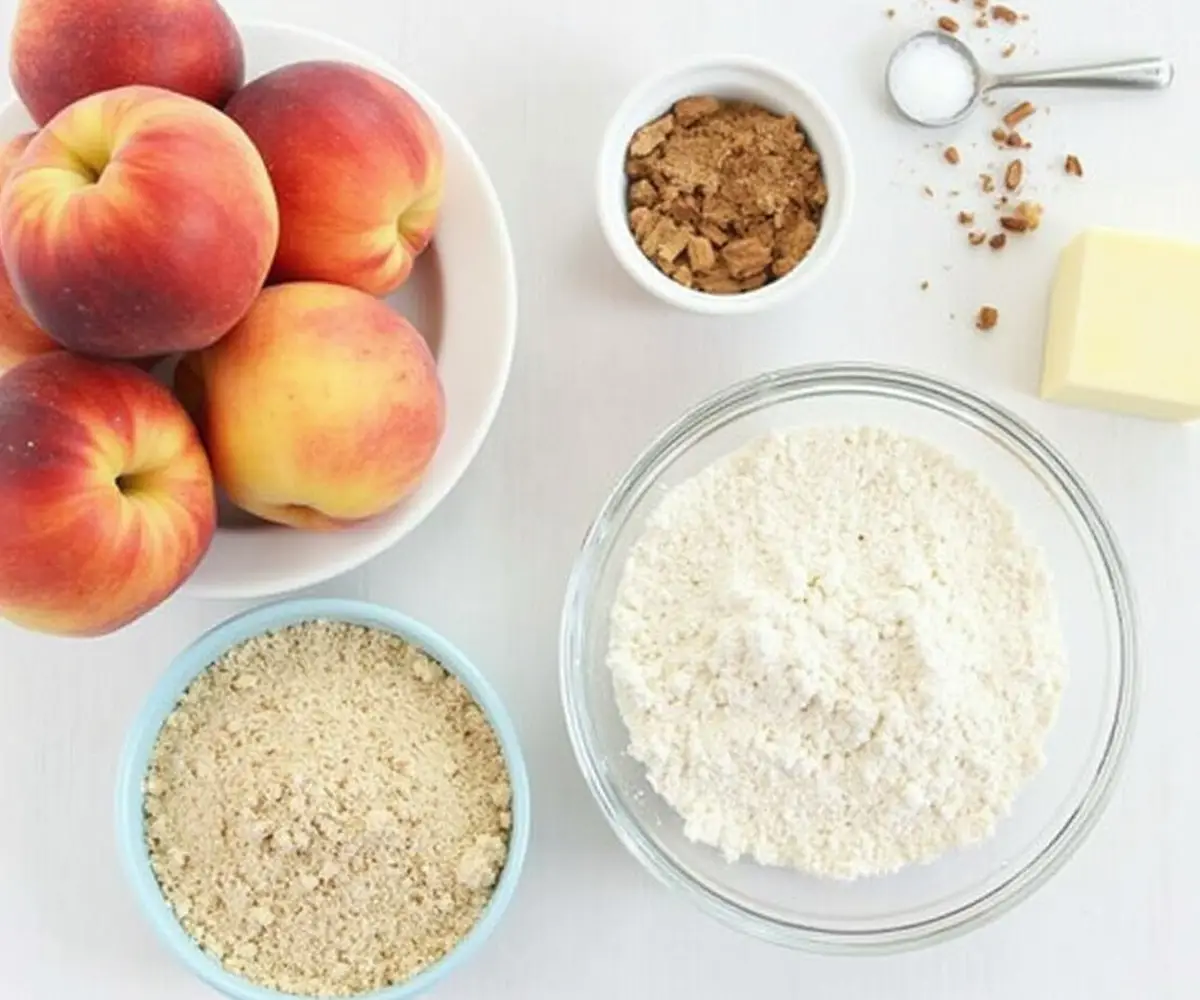
When crafting the perfect gluten-free peach cobbler, choosing the right ingredients is crucial. The beauty of this dessert lies in its simplicity — juicy peaches paired with a buttery, biscuit-like topping. But, to make it gluten-free and just as delicious as the traditional version, we need to select ingredients that bring out the best in both flavor and texture. Let’s explore the key ingredients that make a gluten-free peach cobbler stand out.
The Best Flour for Gluten-Free Cobbler
One of the most important components of any cobbler recipe is the flour used to create that delicious, golden topping. For a gluten-free peach cobbler, the flour options are slightly different, but they can still yield a light, crispy, and tender result.
- Gluten-Free All-Purpose Flour: This is the go-to choice for most gluten-free baking. It’s typically a blend of rice flour, potato starch, and tapioca flour, which mimics the texture and structure of wheat flour. When selecting a gluten-free flour blend, ensure it’s one that includes a binding agent like xanthan gum or guar gum to help hold everything together.
- Almond Flour: If you’re looking to add a nutty flavor to your cobbler, almond flour is an excellent choice. It’s made from finely ground almonds, and it not only provides a moist, dense texture but also gives the cobbler a rich, slightly sweet taste. Almond flour is also lower in carbohydrates, making it a great option for those following a low-carb or keto diet.
- Coconut Flour: Another popular gluten-free flour option, coconut flour is made from dried coconut meat and has a naturally sweet flavor. However, it’s highly absorbent, so it’s important to use less of it in recipes and often pair it with other gluten-free flours like almond flour. Coconut flour also adds a subtle coconut flavor that can elevate your peach cobbler with a tropical twist.
- Rice Flour: Often used as a base for gluten-free flour blends, rice flour is light and gives a delicate, soft texture to baked goods. It’s especially useful in gluten-free peach cobbler when combined with other flours to achieve the perfect balance of texture and flavor.
The choice of flour depends on the desired texture and flavor. You can experiment with different combinations of these flours to find the ideal balance for your cobbler.
Choosing the Perfect Peaches
The star ingredient of any peach cobbler is, of course, the peaches! Selecting the best peaches is key to achieving a fresh and flavorful cobbler.
- Fresh Peaches: If it’s peach season, fresh peaches are always the best option. Choose peaches that are ripe but firm to the touch, with a fragrant smell. They should be slightly soft but not mushy. When using fresh peaches, make sure to peel them for a smoother texture in the cobbler filling. Fresh peaches have the perfect balance of sweetness and acidity, making them ideal for a dessert that’s not too sugary.
- Canned Peaches: When fresh peaches aren’t in season, canned peaches are a great alternative. Opt for canned peaches in light syrup or water rather than heavy syrup to avoid excess sugar. Drain the peaches well before using them in your cobbler, as the extra liquid could make the filling too runny. Canned peaches often lack the vibrant tartness of fresh peaches, but they can still create a tasty dessert.
- Frozen Peaches: If fresh or canned peaches aren’t available, frozen peaches can do the trick. Just be sure to thaw and drain them before using them in your cobbler to prevent excess moisture. Frozen peaches retain much of their flavor and texture, making them a great year-round alternative.
No matter what type of peaches you choose, the goal is to have juicy, tender fruit that will soften and caramelize beautifully as it bakes, creating that perfect contrast between the sweet, warm filling and the crispy topping.
Sweeteners for a Healthier Peach Cobbler
Choosing the right sweeteners for your gluten-free peach cobbler can make a big difference in the final flavor. While traditional cobbler recipes often rely on refined white sugar, you have plenty of healthier, natural alternatives to choose from.
- Coconut Sugar: This unrefined sugar has a mild, caramel-like flavor that pairs beautifully with peaches. It’s lower on the glycemic index than regular sugar, making it a great option for those monitoring their blood sugar levels. Plus, it adds a natural sweetness without overpowering the fruit’s flavor.
- Maple Syrup: If you’re aiming for a more rustic, comforting flavor, maple syrup is an excellent choice. It adds moisture to the cobbler while imparting a subtle maple taste. Make sure to use pure maple syrup rather than artificial versions for the best flavor and quality.
- Honey: For those who prefer a liquid sweetener, honey is a great option. It adds a floral, natural sweetness that complements the peaches well. Honey is also packed with antioxidants, offering some additional health benefits. Just remember that honey is sweeter than sugar, so you may need to reduce the quantity in your recipe.
- Stevia or Monk Fruit Sweetener: If you’re looking for a sugar-free or low-calorie option, stevia or monk fruit sweetener are perfect alternatives. Both provide sweetness without the calories or glycemic impact of traditional sugar. Keep in mind that these sweeteners are much sweeter than sugar, so you’ll only need a small amount.
Using natural sweeteners not only reduces the sugar content of your cobbler but also gives you more control over the overall flavor and texture.
Other Essential Ingredients
- Baking Powder: This is essential for creating that light and fluffy texture in the cobbler topping. Ensure that the baking powder you use is gluten-free, as some brands may contain gluten.
- Butter or Dairy-Free Butter: For a rich, flaky topping, butter is essential. However, for a dairy-free or vegan version, you can substitute with coconut oil or vegan butter. These options will help keep the topping crisp and flavorful without any dairy.
- Cinnamon and Nutmeg: A pinch of cinnamon and nutmeg adds warmth and depth to the filling, bringing out the natural sweetness of the peaches. These spices enhance the overall flavor profile of your peach cobbler, making it even more comforting and aromatic.
- Lemon Juice: A splash of lemon juice helps balance the sweetness of the peaches while adding a touch of acidity. This acidity also helps bring out the bright, fresh flavors of the fruit, making the cobbler taste even more vibrant.
By using high-quality, gluten-free ingredients, you can create a peach cobbler that’s not only delicious but also accessible for those with gluten sensitivities or dietary restrictions. Each ingredient contributes to a final dish that’s warm, sweet, and absolutely irresistible, making this dessert a crowd-pleaser for everyone!
How to Make the Best Gluten-Free Peach Cobbler
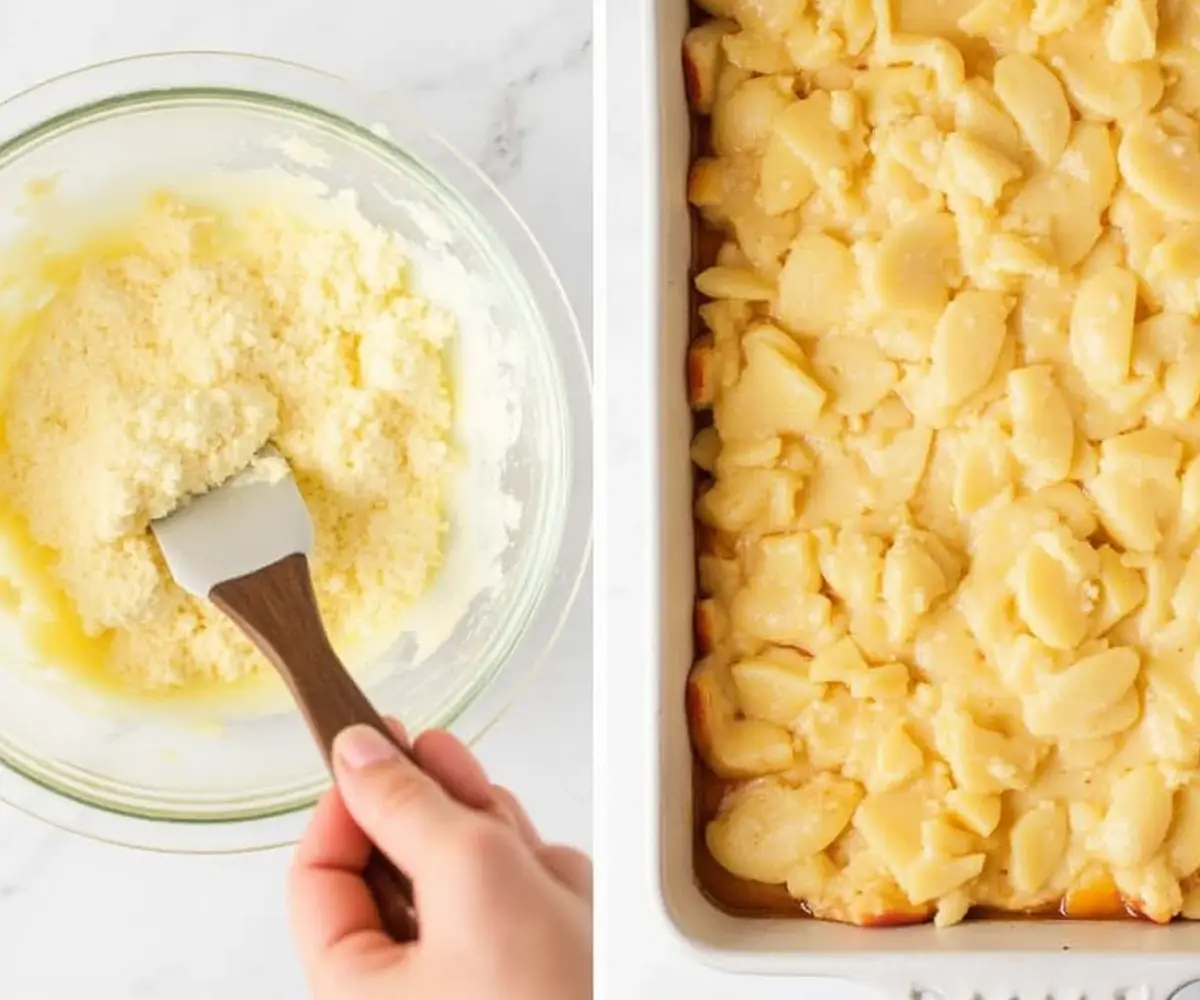
Making the best gluten-free peach cobbler is easier than you might think! With the right ingredients and a few simple steps, you can create a dessert that’s just as delicious and satisfying as the traditional version. Whether you’re a seasoned baker or new to gluten-free cooking, this step-by-step guide will ensure you achieve the perfect balance of sweet, tender peaches and a crisp, golden topping. Let’s walk through how to make this mouthwatering treat from start to finish.
Step 1: Prepare the Peaches
The foundation of any great peach cobbler is the peaches themselves. Whether you’re using fresh, canned, or frozen peaches, it’s essential to prepare them properly to get the best flavor and texture.
- Fresh Peaches: Peel the peaches, then slice them into even pieces. If the peaches are ripe, you should be able to easily peel the skin with your fingers or a paring knife. After slicing, place the peach pieces in a large mixing bowl.
- Canned Peaches: If you’re using canned peaches, choose a version packed in water or light syrup to reduce excess sugar. Drain the peaches well and cut them into smaller pieces, if needed. Canned peaches can sometimes be more watery than fresh peaches, so be sure to pat them dry with a paper towel to remove excess moisture.
- Frozen Peaches: For frozen peaches, let them thaw completely before using them in the recipe. Once thawed, drain off any excess liquid and give them a quick chop if the pieces are too large.
Once your peaches are prepped, toss them with a bit of cinnamon and a splash of lemon juice to enhance their natural sweetness and bring out the fruity flavor.
Step 2: Make the Cobbler Topping
The topping is what truly makes peach cobbler stand out, and with a gluten-free version, you can still achieve that perfect, fluffy texture with a little creativity. Here’s how to prepare the cobbler topping:
- Combine Dry Ingredients: In a separate bowl, mix your gluten-free flour (whether it’s a pre-blended flour or a combination of almond and coconut flour), baking powder, cinnamon, and a pinch of salt. The baking powder will give the topping its light, airy texture.
- Add Sweeteners and Butter: Add the sweetener of your choice (coconut sugar, honey, or maple syrup) to the dry mixture. Then, cut in the butter (or dairy-free butter if you’re going for a dairy-free version) using a pastry cutter or your hands. The butter should be cold, and you want to work it in until the mixture resembles coarse crumbs.
- Add Wet Ingredients: In a separate bowl, whisk together the milk (dairy or non-dairy, depending on your preference) and vanilla extract. Slowly pour the wet ingredients into the dry mixture and stir until just combined. Be careful not to overmix — you want the batter to remain light and fluffy.
- Optional: For added richness, you can fold in some sour cream or Greek yogurt into the batter to give the topping a creamier texture. This addition helps the cobbler maintain moisture as it bakes.
Step 3: Assemble the Cobbler
Once your peach filling and topping are ready, it’s time to assemble your cobbler. This step is quick and straightforward.
- Layer the Peaches: Pour the prepared peach filling into a greased baking dish. Use a 9×9-inch square dish or a similarly sized casserole dish, depending on how many servings you need. The peaches should be spread evenly across the bottom of the dish.
- Top with Cobbler Batter: Using a spoon or an ice cream scoop, dollop the cobbler batter evenly over the peaches. Don’t worry about covering every inch — the batter will spread slightly as it bakes, and some of the peaches will peek through, creating a beautiful rustic look.
- Sprinkle with Sugar: For an extra bit of sweetness and texture, sprinkle a tablespoon of turbinado sugar or coconut sugar over the top of the cobbler before baking. This adds a slight crunch to the topping and a caramelized finish.
Step 4: Bake to Perfection
Now comes the fun part — baking! The cobbler needs to bake at 350°F (175°C) for about 45 to 50 minutes. However, baking times can vary depending on the type of dish you use, the size of your peaches, and your oven, so it’s important to check on the cobbler towards the end of the baking time.
- Check for Doneness: The cobbler is ready when the topping is golden brown and a toothpick or knife inserted into the center comes out clean. You should also notice the peaches bubbling around the edges, indicating that the fruit has cooked through and released its natural juices.
- Let it Cool: Once out of the oven, let the cobbler cool for about 10-15 minutes before serving. This allows the juices to thicken slightly, making it easier to serve and enjoy.
Step 5: Serve and Enjoy
Gluten-free peach cobbler is best served warm, straight from the oven, but it’s also delicious at room temperature. For an extra indulgent treat, top it with a scoop of vanilla ice cream or a dollop of whipped cream. The combination of the warm cobbler, cold ice cream, and juicy peaches is irresistible.
This dessert is perfect for any occasion, from a summer cookout to a cozy winter evening. Its combination of sweet peaches and golden, crumbly topping is sure to delight everyone, whether they follow a gluten-free diet or not.
With this simple method, you can confidently create the best gluten-free peach cobbler, a dessert that’s not only delicious but also meets dietary needs without compromising on flavor or texture.
Tips and Variations for Your Gluten-Free Peach Cobbler
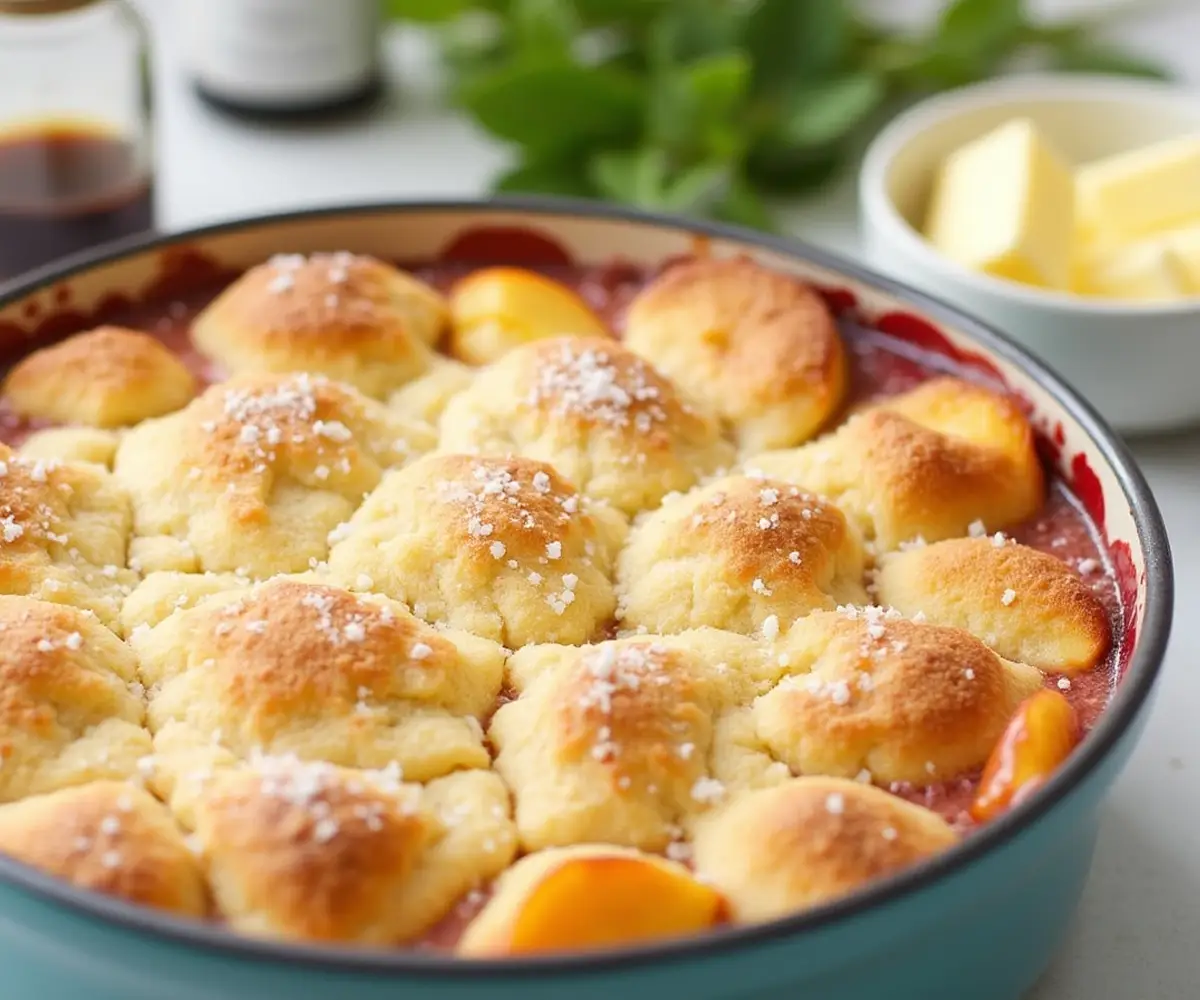
Creating the perfect gluten-free peach cobbler is all about balancing flavors, textures, and ingredients. While the recipe provided is a great starting point, there are several tips and variations you can try to elevate your cobbler or adapt it to suit your preferences and dietary needs. Whether you’re looking to tweak the recipe for a different flavor profile, adjust it for special dietary needs, or make it even easier to prepare, here are some helpful ideas.
Tips for Perfecting Your Gluten-Free Peach Cobbler
- Use a Quality Gluten-Free Flour Blend: The key to a successful gluten-free cobbler lies in your flour blend. Not all gluten-free flours behave the same, so it’s crucial to use a high-quality all-purpose gluten-free flour blend that contains xanthan gum or guar gum. These ingredients help provide structure and elasticity, ensuring your cobbler doesn’t turn out too crumbly or dense. If you’re mixing your own flours, a combination of rice flour, potato starch, and tapioca flour works well. You can also experiment with almond flour for a denser, nuttier texture.
- Ensure the Butter is Cold: For the best cobbler topping, ensure your butter (or dairy-free butter) is cold before cutting it into the dry ingredients. This will help create that delicious, flaky texture in the topping. If you’re short on time, you can even pop the butter in the freezer for a few minutes before using it.
- Let the Cobbler Rest After Baking: After baking your gluten-free peach cobbler, allow it to rest for at least 10-15 minutes before serving. This helps the filling thicken and settle, so you’ll get a better texture when you scoop and serve. It also gives the flavors a bit of time to meld together, making each bite even more flavorful.
- Use Fresh or Frozen Peaches: While canned peaches are convenient, fresh or frozen peaches will provide the best flavor and texture. Fresh peaches have a brighter, more natural sweetness, while frozen peaches maintain their shape well during baking. If using frozen peaches, make sure to drain them thoroughly and pat them dry to avoid excess liquid in the cobbler. You can even mix in some blackberries, blueberries, or raspberries for added depth of flavor.
- Balance the Sweetness: Peaches are naturally sweet, so be mindful of the sugar you add. Depending on the sweetness of the fruit, you may want to reduce the sugar in the filling or topping. Taste the peaches before adding sugar, and remember that the topping will also add some sweetness. Coconut sugar is a great alternative to refined sugar if you’re looking for a more natural sweetener with a caramel-like flavor.
Variations to Try with Your Gluten-Free Peach Cobbler
- Add a Streusel Topping: If you love a little extra crunch on top of your cobbler, try adding a streusel topping. Combine gluten-free flour, rolled oats, brown sugar, and butter (or coconut oil) to create a crumbly topping that adds a delightful texture contrast to the soft peach filling. This variation brings a little extra sweetness and a hearty crunch to each bite.
- Dairy-Free or Vegan Cobbler: Making your cobbler dairy-free or vegan is simple! Replace the butter with coconut oil or a vegan butter substitute. Use almond milk or coconut milk instead of regular milk, and if you want to make it completely vegan, ensure your sweetener is maple syrup or agave nectar (since honey isn’t vegan). You can also swap in a flaxseed or chia egg replacement for the eggs if desired. This version is just as delicious and makes the cobbler suitable for a variety of dietary needs.
- Spice It Up with Flavors: If you love experimenting with flavors, consider adding a little spice to your cobbler to make it even more interesting. A pinch of ginger, nutmeg, or allspice in the peach filling will warm up the flavor profile. For a more exotic twist, try adding a little cardamom or cinnamon to the cobbler topping. These spices bring a cozy depth of flavor that pairs wonderfully with the sweetness of the peaches.
- Cobbler with Other Fruits: While peaches are the star of this dessert, you can easily adapt the recipe to include other fruits. Try a mixed berry peach cobbler by adding blueberries, raspberries, or strawberries to the filling. You could also go for a tropical twist by adding mango or pineapple to the mix. If you want to change up the fruit entirely, apples or plums can work well as substitutes for peaches.
- Add Nuts for Texture: For an added crunch and richness, fold in some chopped nuts like pecans, walnuts, or almonds into the topping. Not only will this enhance the texture, but the nuts will also add a nice contrast to the juicy peaches. You can sprinkle some chopped nuts on top of the cobbler before baking for a beautiful, rustic look and extra flavor.
- Individual Servings: Instead of making one large cobbler, consider making individual gluten-free peach cobbler servings in ramekins or small jars. This not only makes for a charming presentation but also allows for easy portion control. Plus, it’s a fun way to personalize each serving with unique variations, such as adding a scoop of ice cream or a drizzle of caramel sauce on top.
- Add a Splash of Booze: For an adult twist on your cobbler, consider adding a splash of bourbon, rum, or amaretto to the peach filling. The alcohol will cook off, leaving behind a subtle depth of flavor that complements the sweetness of the peaches. Just be careful not to add too much — a tablespoon or two should be enough to give the cobbler a delightful kick.
Gluten-Free Peach Cobbler for Every Occasion
With these helpful tips and exciting variations, you can customize your gluten-free peach cobbler to suit any occasion or preference. Whether you stick to the classic recipe or try something new, you’re sure to have a dessert that’s both delicious and accommodating to different dietary needs. From adding a little spice to making it dairy-free or vegan, your cobbler will be an unforgettable treat for friends and family!
Frequently Asked Questions (FAQs)
Can I use canned peaches for gluten-free peach cobbler?
Yes, you can use canned peaches for your gluten-free peach cobbler, but fresh or frozen peaches tend to provide a better flavor and texture. If you choose canned peaches, make sure to drain them well and pat them dry to remove excess moisture, which could affect the consistency of the cobbler filling.
Is it possible to make gluten-free peach cobbler ahead of time?
Absolutely! You can prepare the peach cobbler in advance and store it in the refrigerator for up to 2 days before baking. Alternatively, you can bake it ahead of time, let it cool, and then refrigerate it. When you’re ready to serve, simply reheat the cobbler in the oven at 350°F (175°C) for about 10-15 minutes until it’s warmed through.
Can I make gluten-free peach cobbler dairy-free?
Yes, making your gluten-free peach cobbler dairy-free is easy! Simply substitute the butter with coconut oil, vegan butter, or olive oil. For the milk, you can use almond milk, coconut milk, or oat milk as a non-dairy alternative. These swaps will ensure your cobbler is both dairy-free and gluten-free.
How do I make the cobbler topping crispier?
To achieve a crispier cobbler topping, ensure that the butter is cold before mixing it with the dry ingredients. You can also try sprinkling a little coconut sugar or demerara sugar over the topping before baking. The sugar helps create a golden, caramelized crust. Additionally, baking the cobbler on the middle rack of your oven allows the heat to distribute evenly, ensuring a crisp finish.
Can I substitute the sugar with a healthier alternative?
Yes! If you’re looking for a healthier sugar alternative, you can substitute the granulated sugar with coconut sugar, honey, or maple syrup. Keep in mind that these alternatives may slightly change the texture or flavor of the cobbler. For a sugar-free option, consider using Stevia or Erythritol, though you’ll need to adjust the amount as these sweeteners can be much sweeter than regular sugar.
Conclusion
Making a gluten-free peach cobbler is a delightful way to enjoy a comforting, delicious dessert that caters to dietary needs without sacrificing flavor. Whether you’re baking for yourself, a family gathering, or a special occasion, this dessert is sure to impress with its sweet, juicy peaches and tender, golden topping. By using simple ingredients and following a few easy steps, you can create a dish that’s as satisfying as it is versatile.
From making adjustments for dairy-free or vegan diets to exploring exciting flavor variations, the possibilities with gluten-free peach cobbler are endless. With the tips and variations shared in this post, you’re equipped to craft the perfect cobbler every time. So, gather your ingredients, preheat your oven, and get ready to enjoy a homemade treat that celebrates the flavors of fresh peaches in every bite. Your gluten-free peach cobbler will quickly become a beloved favorite in your baking repertoire!
Explore More Recipes: Visit Cucina Recipes to find even more delicious meal ideas to inspire your next cooking adventure!
Did you make this recipe?
Mention @cucinarecipes or tag #cucinarecipes!

